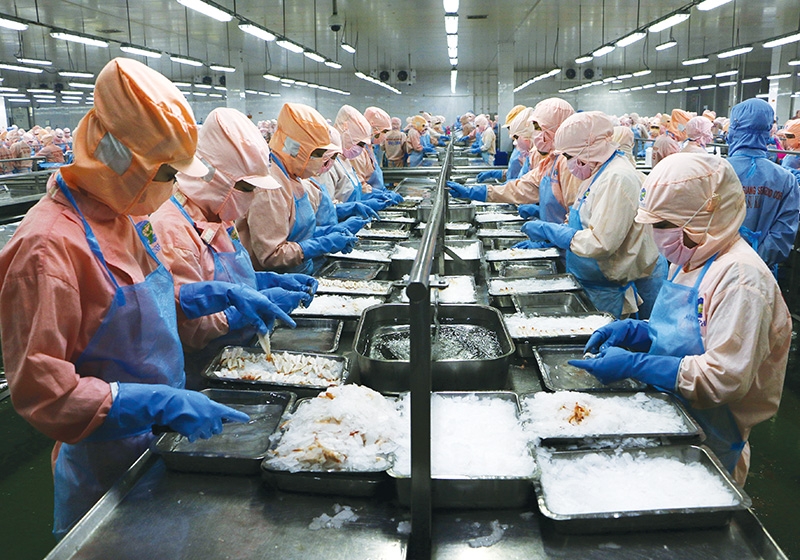Shrimp leading the charge in seafood sector recovery
 |
| Shrimp leading the charge in seafood sector recovery |
From the beginning of 2020 to February, Vietnam’s exports have gone through many challenges due to the disruption of global value chains as an aftermath the impact of the pandemic. However, a recovery has taken place in the recent two months, with the country’s seafood exports increasing by 17 and 30 per cent on-year in March and April, respectively.
Vietnamese shrimp exporters benefitted from the unexpected COVID-19 wave in India – the world’s leading shrimp exporter. India produced around 650,000-700,000 tonnes of shrimp in 2020, down 30 per cent from 2019. The recent outbreak in India has made the situation worse, contrary to many forecasts for production. Shrimp production volume in India may recover in the second half of 2021. Thus, this provides an opportunity for competitors like Ecuador, Indonesia, and Vietnam to improve their market shares in the importing countries – especially in the United States.
According to India’s National Oceanic and Atmospheric Administration (NOAA), this nation’s warm-water raw shrimp exports to the US fell 9 per cent in volume and 10 per cent in value on-year in Q1. Meanwhile, its competitors continued to grow. Ecuador was an immediate beneficiary, with 37 per cent growth in output and 44 per cent growth in value during the quarter. The South American nation has a competitive advantage thanks to the lowest average selling price among the top five countries and its direct rivalry with India.
Vietnam recorded a 41-per-cent increase in shrimp exports in volume and a 10-per-cent increase in value compared to the first quarter of 2020, with opportunities to expand the market share in the US. For raw shrimps, Vietnam’s export price remains high compared to competitors, due to the proportion of black tiger shrimp with a higher average selling price.
The average selling price for raw whiteleg shrimp remains stable at $10 per kg, and the average selling price in the first quarter decreased due to the change in product structure to reduce the proportion of black tiger shrimp with higher prices. The ratio of whiteleg shrimp to black tiger shrimp sales changed from 87/13 in the first quarter of 2020 to 91/9 in the first quarter of 2021. This is because black tiger shrimp is commonly consumed in restaurants and hotel that remain partially closed due to the pandemic.
The global health crisis has also changed consumer behaviour, in which the demand for processed shrimp has increased significantly, which has been a competitive advantage of Vietnam over Ecuador in the US market and for all competitors in the global market like the EU and Japan. The Vietnam Association of Seafood Exporters and Producers (VASEP) forecasts that Vietnam’s shrimp exports will continue to increase due to a slight increase in the global demand while the supply from many producing countries will decrease due to COVID-19.
Meanwhile, exporters of basa fish also benefited from the recovery in the US’ demand. Vietnam’s basa exports increased 3 per cent on-year in the first quarter and 26 per cent in the first half of April, of which exports to the US rebounded at 16 and 120 per cent respectively.
VASEP also estimated that the average selling price from December to January had bottomed out due to both cyclical factors and the demand that was easily affected by the pandemic, and the average selling price of all markets will recover at the end of the year.
In the second quarter, VASEP expects shrimp and basa exports to increase by 10 and 7 per cent, respectively, over the same period. By the end of the year, Vietnam’s seafood exports can benefit from gaining a bigger market share from competitors whose production output has been negatively affected by the pandemic and continue to grow from retail and online sales while the demand from restaurants will slowly recover.
What the stars mean:
★ Poor ★ ★ Promising ★★★ Good ★★★★ Very good ★★★★★ Exceptional
Related Contents
Latest News
More News
- Vietnam's top 500 value-creating enterprises announced (December 27, 2025 | 08:00)
- The PAN Group shaping a better future with ESG strategy (December 26, 2025 | 09:00)
- Masan Consumer officially lists on HSX, marking the next phase of value creation (December 25, 2025 | 13:20)
- MCH to become the largest consumer stock on VN-Index (December 24, 2025 | 11:05)
- Oil and gas firms post strong 2025 results (December 22, 2025 | 17:42)
- SABECO wins multiple international beer awards (December 22, 2025 | 17:41)
- UOB sees Vietnam growth easing in fourth quarter (December 22, 2025 | 17:39)
- First members of Danang International Finance Centre revealed (December 22, 2025 | 17:39)
- Human-centred governance seen as key to AI development (December 19, 2025 | 18:19)
- Top 10 notable events of Vietnam’s industry and trade sector in 2025 (December 19, 2025 | 14:00)

 Tag:
Tag:






















 Mobile Version
Mobile Version